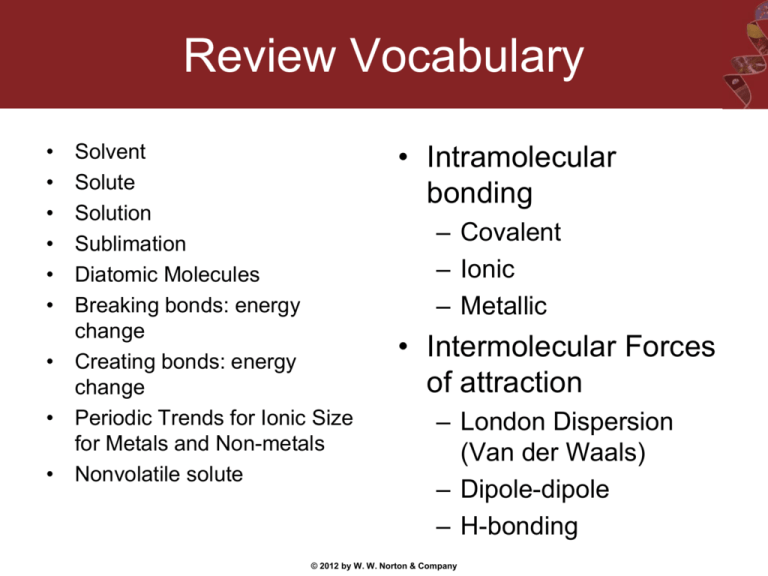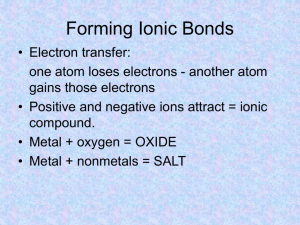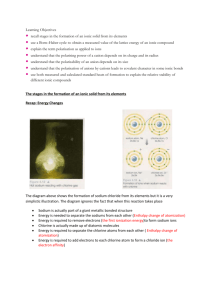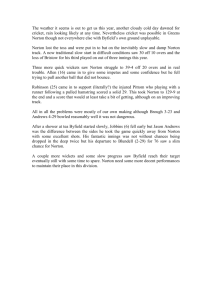Wiki Ermann_LecturePPT_Ch_11 Part 1
advertisement

Review Vocabulary • • • • • • Solvent Solute Solution Sublimation Diatomic Molecules Breaking bonds: energy change • Creating bonds: energy change • Periodic Trends for Ionic Size for Metals and Non-metals • Nonvolatile solute • Intramolecular bonding – Covalent – Ionic – Metallic • Intermolecular Forces of attraction – London Dispersion (Van der Waals) – Dipole-dipole – H-bonding © 2012 by W. W. Norton & Company Enthalpy of Solution – the overall heat change when a solute is dissolved in a solvent Dissolution of Ionic Solids: • Enthalpy of solution (ΔHsoln) depends on: » Energies holding solute ions in crystal lattice. » Attractive force holding solvent molecules together. » Interactions between solute ions and solvent molecules. • ΔHsoln = ΔHion-ion + ΔHdipole-dipole + ΔHion-dipole • When solvent is water: » ΔHsoln = ΔHion-ion + Δhhydration » Video: http://youtu.be/CLHP4r0E7hg © 2012 by W. W. Norton & Company Lattice Energy Lattice energy (U): • The energy released when one mole of the ionic compound forms from its free ions in the gas phase. M+(g) + X−(g) → MX(s) k ( Q Q ) 1 2 U= d • Where k is proportionality constant, depends on lattice structure – usually the same for compounds with the same or nearly the same structure. © 2012 by W. W. Norton & Company Comparing Lattice Energies k ( Q Q ) 1 2 U= d Lattice energy depends on: • ionic charge • ionic radius © 2012 by W. W. Norton & Company ΔHion-ion Lattice energy (U)—energy released when crystal lattice is formed. ΔHion-ion = energy required to remove ions from crystal lattice. ΔHion-ion = −U And: ΔHsoln = ΔHhydration − U (Example Problem 1) © 2012 by W. W. Norton & Company Melting Point and Lattice Energy Ions that are tightly held together require more energy to break apart How much energy depends upon the nucleus-to-nucleus distance between ions As distance between ions increases, the lattice energy decreases Also, k must be the same for all compounds under consideration © 2012 by W. W. Norton & Company Melting Point and Lattic Energy Example: Rank the following in order of increasing lattice energy (assume all have the same solid structure and k value) NaF KF RbF © 2012 by W. W. Norton & Company Melting Point and Multivalent Ionic Compounds The columbic (electrostatic) attraction between doubly charged spieces, or between them and singly charged ions, are much stronger than those between singly charged ions and cations. Example 2: Predict which compound has the highest melting point: CaCl2, PbBr2 , or TiO2. All have the same k and the radius of Ti+4 is 60.5 p.m. © 2012 by W. W. Norton & Company Born-Haber Cycle and Lattice Energy Born-Haber Cycle: • Algebraic sum of enthalpy changes associated with formation of ionic solid from constituent elements. • E.g., Na(s) + ½ Cl2(g) → NaCl(s) ΔHf° = −411.2 kJ Steps: 1. sublimation of 1 mole Na(s) → Na(g) = ΔHsub = 109 kJ 2. breaking bonds of ½ mole of Cl2(g) = ½ ΔHBE 240kJ/n 3. ionization of 1 mole Na(g) atoms = IE1 495 kJ 4. ionization of 1 mole Cl(g) atoms = EA1 -349 kJ 5. formation of 1 mole NaCl(s) from ions(g) = U © 2012 by W. W. Norton & Company ? Born-Haber Cycle for NaCl ΔHf° = ΔHsub + ½ ΔHBE + IE1 + EA1 + U © 2012 by W. W. Norton & Company Born-Haber Cycle http://youtu.be/BbTZoJ_K_l4 Video is embedded on the Chapter 11 Topic Page on WCSUErmann.wikispaces.com website © 2012 by W. W. Norton & Company Calculating U ΔHf° = ΔHsub + ½ ΔHBE + IE1 + EA1 + U Rearrange to solve for U U = ΔHf° - ΔHsub - ½ ΔHBE - IE1 - EA1 © 2012 by W. W. Norton & Company Born-Haber Cycle: ΔHhydration The Born-Haber Cycle can also be used to determine the Enthalpy of Hydration. Once we have found U, we can find Δhhydration. © 2012 by W. W. Norton & Company Born-Haber Cycle: ΔHhydration ΔHsolution,NaCl = ΔHhydration,NaCl(aq) – UNaCl ΔHhydration,NaCl(aq) = ΔHhydration,Na+(g) + ΔHhydration,Cl−(g) © 2012 by W. W. Norton & Company Enthalpies of Hydration © 2012 by W. W. Norton & Company Vapor Pressure Vapor pressure: • Pressure exerted by a gas in equilibrium with its liquid. • Rates of evaporation and condensation are equal. © 2012 by W. W. Norton & Company





